Starhawk (1979 video game)
Starhawk is a 1979 vector arcade game designed and programmed by Tim Skelly and manufactured by Cinematronics.[1] Starhawk is a shoot 'em up unofficially based on the Star Wars: Episode IV trench run, the first arcade game to blatantly use concepts from Star Wars.[2] The game was unique at the time for its pseudo-3D graphics. It was released for the Vectrex home system in 1982.
| Starhawk | |
|---|---|
 Vectrex cartridge | |
| Developer(s) | Cinematronics |
| Publisher(s) | Cinematronics |
| Designer(s) | Tim Skelly |
| Platform(s) | Arcade, Vectrex |
| Release | 1979: Arcade 1982: Vectrex |
| Genre(s) | Fixed shooter |
| Mode(s) | Up to two players, simultaneously |
| Cabinet | Upright |
| Arcade system | CCPU cpu @ 5 MHz Mono sound |
| Display | Vector graphics X-Y monitor |
The arcade cabinet had a cinder block placed inside of it, to prevent it from tipping onto the player.[2]
Plot
According to the Vectrex manual, the story involves "protecting your comrades from alien ships trying to infiltrate your culture" and "defending the sovereignty of your planet."
Gameplay
Various ships, reminiscent of TIE fighters, appear on the horizon of the trench and the player has to shoot them before they destroy the player's ship. The player is given initially sixty seconds, but additional twenty seconds is awarded for every 10,000 points scored. The player continues flying down the trench towards a target similar to the Star Wars Death Star target. The game gets progressively more difficult as the player advances. Similar to the flying saucer from Space Invaders, a command ship periodically appears and shoots at the player. If the command ship is not destroyed quickly, the player loses 800 points.
Besides the firing button, there are three buttons that control the speed of the crosshairs.
Scoring
- Command ship: 800
- Starship: 500
- Rocket: 300
- Missile: 100
- Bomber: 100
See also
References
- Hague, James. "The Giant List of Classic Game Programmers".
- Wirtanen, Josh. "The First Star Wars Arcade Game Wasn't Officially a Star Wars Game". Retrovolve. Retrieved 20 July 2016.